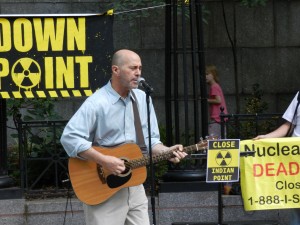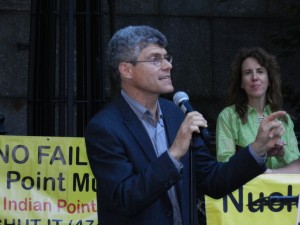Activists clamor for Indian Point shutdown

With reports expressing renewed concerns that Japan”™s Fukushima Daiichi nuclear power facility is still emitting high levels of radioactivity, activists gathered in New York Aug. 11 to rally for the closing of Indian Point.
The rally drew some 100 spectators and was organized by Greenpeace USA. It featured former congressman John Hall, U.S. Rep. Jerrold Nadler, D-8th District and Paul Gallay, president of the Ossining-based environmental group Riverkeeper, among others, who all advocated for the licenses of the two nuclear generators at Indian Point in Buchanan to not be renewed by the U.S. Nuclear Regulatory Commission.
“It”™s old, it”™s dangerous and it”™s unnecessary,” Gallay said. “Indian Point was never meant to go beyond its 40-year lifespan,” he said, adding that with nearly 20 million people living within a 50-mile radius of the plants, renewing the operating licenses, which expire in 2013 and 2015 respectively, would represent an unnecessary risk to the region.

Energy industry representatives struck back, saying the emissions-free energy generated at Indian Point cannot be replaced without incurring huge costs for Westchester and New York consumers, and that moreover, closing the plants would result in the losses of 1,300 jobs in the county.
“Across the board, I think you”™re talking about, on average, a 10 percent increase (in costs) because power would have to be purchased by other sources,” said Jerry Kremer, chairman of the New York Affordable Reliable Electricity Alliance, citing the recent study completed by the Charles River Association on behalf of the New York City Department of Environmental Protection.
He said the increase in costs might even be higher. “If Westchester and the region”™s consumers were at the mercy of out-of-state providers, there”™s no question that that 10 percent figure might be conservative,” Kremer said. “Whether it”™s three years from now or whether it was 10 years from now, there would be a jolt to the economy of the region that would take years to recover from.”

In addition to cost increases, the Charles River Association study said closing Indian Point would likely result in the use of less environmentally friendly means of generating power. The study said that under most conclusions, residents could expect a 15 percent increase in carbon emissions relative to the nuclear power plants, which put out zero carbon emissions.
Curiously, John Hall, speaking in opposition to Indian Point, said, “What we need to do is to bring online safe, renewable, non-polluting sources of energy.”
However, spokesmen for Entergy Nuclear, which is responsible for running the two plants at Indian Point, and for Consolidated Edison, the region”™s biggest provider of electricity, both touted the renewable and environmentally friendly nature of Indian Point.
“For a state that has regional greenhouse gas initiatives, they become unachievable with the shutdown of Indian Point,” said Jim Steets, spokesman for Entergy.
In a statement from Con Edison, spokesman Allen Drury said the approximately 2,000 megawatts produced by the plants are needed to meet the region”™s energy demand.
“The units are also a significant low cost, emissions-free source of electricity for the greater New York region,” he said. “Their retirement and replacement with what would likely be fossil-fuel plants would mean higher electricity costs and increased greenhouse gas and other air emissions.”
Currently, Entergy Nuclear employs 1,100 people at its plants on a daily basis, in addition to some 200 outside contractors who work there every day.